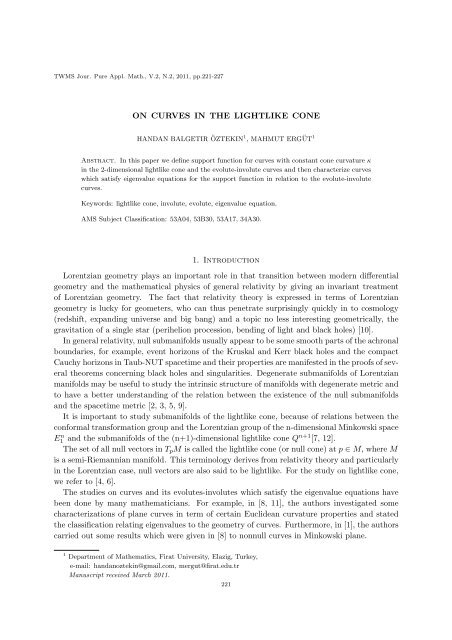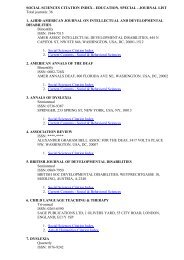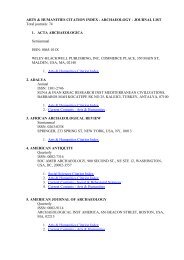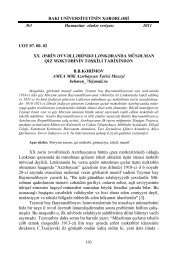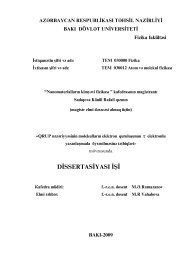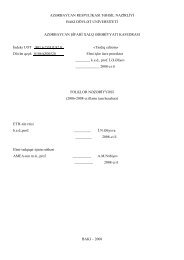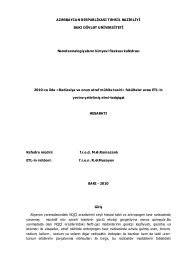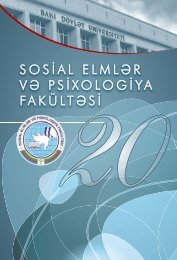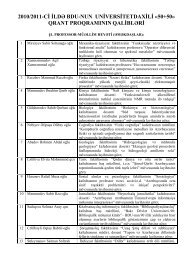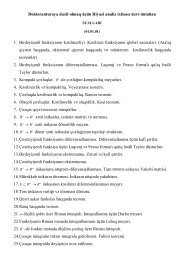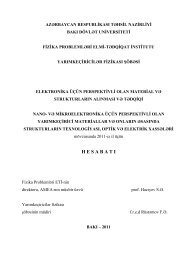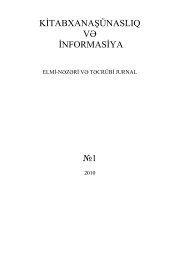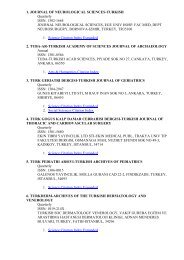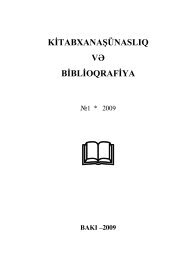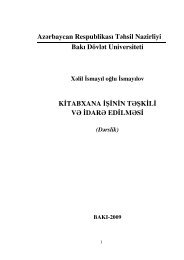ON CURVES IN THE LIGHTLIKE CONE 1. Introduction Lorentzian ...
ON CURVES IN THE LIGHTLIKE CONE 1. Introduction Lorentzian ...
ON CURVES IN THE LIGHTLIKE CONE 1. Introduction Lorentzian ...
You also want an ePaper? Increase the reach of your titles
YUMPU automatically turns print PDFs into web optimized ePapers that Google loves.
TWMS Jour. Pure Appl. Math., V.2, N.2, 2011, pp.221-227<strong>ON</strong> <strong>CURVES</strong> <strong>IN</strong> <strong>THE</strong> <strong>LIGHTLIKE</strong> C<strong>ON</strong>EHANDAN BALGETIR ÖZTEK<strong>IN</strong>1 , MAHMUT ERGÜT1Abstract. In this paper we define support function for curves with constant cone curvature κin the 2-dimensional lightlike cone and the evolute-involute curves and then characterize curveswhich satisfy eigenvalue equations for the support function in relation to the evolute-involutecurves.Keywords: lightlike cone, involute, evolute, eigenvalue equation.AMS Subject Classification: 53A04, 53B30, 53A17, 34A30.<strong>1.</strong> <strong>Introduction</strong><strong>Lorentzian</strong> geometry plays an important role in that transition between modern differentialgeometry and the mathematical physics of general relativity by giving an invariant treatmentof <strong>Lorentzian</strong> geometry. The fact that relativity theory is expressed in terms of <strong>Lorentzian</strong>geometry is lucky for geometers, who can thus penetrate surprisingly quickly in to cosmology(redshift, expanding universe and big bang) and a topic no less interesting geometrically, thegravitation of a single star (perihelion procession, bending of light and black holes) [10].In general relativity, null submanifolds usually appear to be some smooth parts of the achronalboundaries, for example, event horizons of the Kruskal and Kerr black holes and the compactCauchy horizons in Taub-NUT spacetime and their properties are manifested in the proofs of severaltheorems concerning black holes and singularities. Degenerate submanifolds of <strong>Lorentzian</strong>manifolds may be useful to study the intrinsic structure of manifolds with degenerate metric andto have a better understanding of the relation between the existence of the null submanifoldsand the spacetime metric [2, 3, 5, 9].It is important to study submanifolds of the lightlike cone, because of relations between theconformal transformation group and the <strong>Lorentzian</strong> group of the n-dimensional Minkowski spaceE1 n and the submanifolds of the (n+1)-dimensional lightlike cone Qn+1 [7, 12].The set of all null vectors in T p M is called the lightlike cone (or null cone) at p ∈ M, where Mis a semi-Riemannian manifold. This terminology derives from relativity theory and particularlyin the <strong>Lorentzian</strong> case, null vectors are also said to be lightlike. For the study on lightlike cone,we refer to [4, 6].The studies on curves and its evolutes-involutes which satisfy the eigenvalue equations havebeen done by many mathematicians. For example, in [8, 11], the authors investigated somecharacterizations of plane curves in term of certain Euclidean curvature properties and statedthe classification relating eigenvalues to the geometry of curves. Furthermore, in [1], the authorscarried out some results which were given in [8] to nonnull curves in Minkowski plane.1 Department of Mathematics, Firat University, Elazig, Turkey,e-mail: handanoztekin@gmail.com, mergut@firat.edu.trManuscript received March 201<strong>1.</strong>221
222 TWMS JOUR. PURE APPL. MATH., V.2, N.2, 2011In this manuscript, due to importance of eigenvalue equation and curves theory in applicationof the submanifolds theory, we studied the curves and its evolutes-involutes, and characterizedthem with respect to eigenvalue equations for its support function.2. Curves in the lightlike cone Q n+1Let E m qbe the m−dimensional pseudo-Euclidean space with the metricG(x, y) =< x, y >=m−q∑i=1x i y i −m∑j=m−q+1x j y j ,where x = (x 1 , x 2 , ..., x m ), y = (y 1 , y 2 , ..., y m ) ∈ Eq m . Eqm is a flat pseudo-Riemannian manifoldof signature (m − q, q).Let M be a submanifold of Eq m . If the pseudo-Riemannian metric G of Eqm induces a pseudo-Riemannian metric G (respectively, a Riemannian metric, a degenerate quadratic form) on M,then M is called a timelike (respectively, spacelike, degenerate) submnifold of Eq m .Let c be a fixed point in Eqm and r > 0 be a constant. The pseudo-Riemannian sphere isdefined bySq n (c, r) = {x ∈ Eq n+1 : G(x − c, x − c) = r 2 };the pseudo-Riemannian hyperbolic space is define byH n q (c, r) = {x ∈ E n+1q+1 : G(x − c, x − c) = −r2 };the pseudo-Riemannian lightlike cone (quadric cone) is defined byQ n q (c) = {x ∈ E n+1q : G(x − c, x − c) = 0}.It is well-known that Sq n (c, r) is a complete pseudo-Riemannian hypersurface of signature(n − q, q), q ≥ 1, in Eqn+1 with constant sectional curvature r −2 ; Hq n (c, r) is complete pseudo-Riemannian hypersurface of signature (n−q, q), q ≥ 1, in Eq+1 n+1 with constant sectional curvature−r −2 ; Q n q (c) is a degenerate hypersurface in Eqn+1 . The spaces Eq n , Sq n (c, r) and Hq n (c, r) arecalled pseudo-Riemannian space forms. The point c is called the center of Sq n (c, r), Hq n (c, r) andQ n q (c). When c = 0 and q = 1, we simply denote Q n 1 (0) by Qn and call it the lightlike cone (orsimply the light cone) [10].Let E1 n+2 be the (n + 2)−dimensional Minkowski space and Q n+1 the lightlike cone in E1 n+2 .A vector α ≠ 0 in E1 n+2 is called spacelike, timelike or lightlike, if < α, α >> 0, < α, α >< 0 or< α, α >= 0, respectively. A frame field {e 1 , .., e n , e n+1 , e n+2 } on E1 n+2 is called an asymptoticorthonormal frame field, ifWe assume that the curve< e n+1 , e n+1 >=< e n+2 , e n+2 >= 0, < e n+1 , e n+2 >= 1,< e n+1 , e i >=< e n+2 , e i >= 0, < e i , e j >= δ ij , i, j = 1, ..., n.x : I → Q n+1 ⊂ E n+21 , t → x(t) ∈ Q n+1 , t ∈ I ⊂ Ris a regular curve in Q n+1 . In the following, we always assume that the curve regular andx(t) ∦ x ′ (t) = dx(t)dt, for all t ∈ I.Definition 2.<strong>1.</strong> A curve x(t) in E n+21 is called a Frenet curve, if for all t ∈ I, the vector fieldsx(t), x ′ (t), x ′′ (t), ..., x (n) (t), x (n+1) (t) are linearly independent and the vector fields x(t), x ′ (t),x ′′ (t), ..., x (n+1) (t), x (n+2) (t) are linearly dependent, where x (n) (t) = dxn (t)dt n . Since < x, x >= 0
H.B. ÖZTEK<strong>IN</strong>, M. ERGÜT: <strong>ON</strong> <strong>CURVES</strong> <strong>IN</strong> <strong>THE</strong> <strong>LIGHTLIKE</strong> C<strong>ON</strong>E 223and < x, dx >= 0, dx(t) is spacelike. Then the induced arc length (or simply the arc length) sof the curve x(t) can be defined byds 2 =< dx(t), dx(t) > .If we take the arc length s of the curve x(t) as the parameter and denote x(s) = x(t(s)), thenx ′ (s) = dxdsis a spacelike unit tangent vector field of the curve x(s). Now we choose the vectorfield y(s), the spacelike normal space V n−1 of the curve x(s) such that they satisfy the followingconditions:< x(s), y(s) >= 1, < x(s), x(s) >=< y(s), y(s) >=< x ′ (s), y(s) >= 0,V n−1 = {span R {x, y, x ′ }} ⊥ , span R {x, y, x ′ , V n−1 } = E n+21 .Therefore, choosing the vector fields α 2 (s), α 3 (s), ..., α n (s) ∈ V n−1 suitably, we have thefollowing Frenet formulasx ′ (s) = α 1 (s)α ′ 1 (s) = κ 1(s)x(s) − y(s) + τ 1 (s)α 2 (s)α ′ 2 (s) = κ 2(s)x(s) − τ 1 (s)α 1 (s) + τ 2 (s)α 3 (s)α ′ 3 (s) = κ 3(s)x(s) − τ 2 (s)α 2 (s) + τ 3 (s)α 4 (s)...α ′ i (s) = κ i(s)x(s) − τ i−1 (s)α i−1 (s) + τ i (s)α i+1 (s)...α ′ n−1 (s) = κ n−1(s)x(s) − τ n−2 (s)α n−2 (s) + τ n−1 (s)α n (s)α n(s) ′ = κ n (s)x(s) − τ n−1 (s)α n−1 (s)y ′ ∑(s) = − n κ i (s)α i (s),i=1where α 2 (s), α 3 (s), ..., α n (s) ∈ V n−1 , < α i , α j >= δ ij , i, j = 1, 2, ..., n. The function κ 1 (s), ...,κ n (s), τ 1 (s), ..., τ n−1 (s) are called cone curvature functions of the curve x(s). The frame{x(s), y(s), α 1 (s), α 2 (s), ..., α n (s)}is called the asymptotic orthonormal frame on E n+21 along the curve x(s) in Q n+1 .3. Curves with constant cone curvature in the lightlike cone Q 2In this section, we consider curves in the lightlike cone Q 2 and define support function forcurves with constant cone curvature κ in the 2−dimensional lightlike cone and the evoluteinvolutecurves and then characterize curves which satisfy eigenvalue equations for the supportfunction in relation to the evolute-involute curves.Let x : I → Q 2 ⊂ E1 3 be a curve, then from (1), we havex ′ (s) = α(s),y ′ (s) = −κ(s)α(s),α ′ (s) = κ(s)x(s) − y(s),where s is an arc length parameter of the curve x(s) and x(s), y(s), α(s) satisfy< x, x >=< y, y >=< x, α >=< y, α >= 0,< x, y >=< α, α >= <strong>1.</strong>For an arbitrary parameter t of the curve x(t), the cone curvature function κ is given byκ(t) = < dxdt , d2 x> 2 − < d2 x, d2 x>< dxdt 2dt 2 dt 2 dt , dxdt >2 < dxdt , dx. (3)dt >5(1)(2)
224 TWMS JOUR. PURE APPL. MATH., V.2, N.2, 2011Using a orthonormal frame on the curve x(s) and denoting by κ, τ, β and γ the curvature,the torsion, the principal normal and the binormal of the curve x(s) in E1 3 , we havex ′ = αα ′ = κx − y = κβ,where κ ≠ 0, < β, β >= ε = ±1, < α, β >= 0, < α, α >= 1, εκ < 0. Then we getChoosingwe obtainβ = ε κx − y √ −2εκ, ετγ =γ =κ = √ −2εκ,κ ′2 √ −2εκ (x + 1 y). (4)κ√−εκ2 (x + 1 y) (5)κτ = − 1 2 (κ′ ). (6)κTheorem 3.<strong>1.</strong> The curve x : I → Q 2 is a planar curve if and only if the cone curvature functionκ of the curve x(s) is constant [6].If the curve x : I → Q 2 ⊂ E 3 1is a planar cure, then we have the following Frenet formulasx ′ = α,α ′ = ε √ −2εκβ,β ′ = − √ −2εκα.(7)Definition 3.<strong>1.</strong> Let x : I → Q 2 be a curve with constant cone curvature κ and arc lengthparameter s, then the support function of x(s) with respect to a fixed point p 0 ∈ Q 2 is defined byDifferentiating (8) with respect to s and using (7), we haveρ(p 0 ) =< β, p 0 − x > . (8)ρ ′ (p 0 ) = − √ −2εκ < α, p 0 − x > (9)and we get a representation of x(s) in terms of the support function:x − p 0 =1√ −2εκρ ′ (p 0 )α − ερ(p 0 )β. (10)Theorem 3.2. Let x : I → Q 2 be a curve with constant cone curvature κ and arc lengthparameter s, then the support function ρ(p 0 ) of x(s) with respect to a fixed point p 0 ∈ Q 2 can bewritten as follows:(i) ρ(p 0 )(s) = c 1 s + c 2 ,for κ = 0, it is a part of circle;(ii) ρ(p 0 )(s) = c 1 cos √ −2κs + sin √ −2κs + √ 1−2κ,for ε = 1, κ < 0, it is an ellipse;(iii) ρ(p 0 )(s) = c 1 cosh √ 2κs + c 2 sinh √ 2κs − √ 12κ,for ε = −1, κ > 0, it is a hyperbola; where c 1 , c 2 ∈ E 3 1 .Proof. Differentiating (10), we get1√ −2εκρ ′′ (p 0 ) + ε √ −2εκρ(p 0 ) = <strong>1.</strong> (11)
H.B. ÖZTEK<strong>IN</strong>, M. ERGÜT: <strong>ON</strong> <strong>CURVES</strong> <strong>IN</strong> <strong>THE</strong> <strong>LIGHTLIKE</strong> C<strong>ON</strong>E 225Solving this equation (11), we obtain thatρ(p 0 )(s) = c 1 s + c 2 , κ = 0,ρ(p 0 )(s) = ρ(p 0 )(s) = c 1 cos √ −2κs + sin √ −2κs + 1 √ −2κ, ε = 1, κ < 0,ρ(p 0 )(s) = c 1 cosh √ 2κs + c 2 sinh √ 2κs − 1 √2κ, ε = −1, κ > 0,where c 1 , c 2 ∈ E 3 1 .□Definition 3.2. Let x : I → Q 2 be a curve with constant cone curvature κ and arc lengthparaameter s. Then the locus of the centre of curvature of a planar curve x(s) is called theevolute of the curve x(s) and given byE x (s) = x(s) +From (12), the evolute curve E x is not regular curve.1√ −2εκβ(s). (12)Definition 3.3. Let x : I → Q 2 be a curve with constant cone curvature κ and arc lengthparameter s. For a fixed value s 1 ∈ R, the involute of the curve x(s) is defined byIf we derivative of (13) with respect to s, we getI x,s1 (s) := x(s) − (s + s 1 )α(s). (13)I ′ x,s 1(s) = −ε(s + s 1 ) √ −2εκβ(s). (14)Thus the condition (s + s 1 ) ≠ 0 is equivalent to the regularity of the involute I x,s1 and wesuppose all involutes to be regular. If s 1 varies, one obtains a one-parameter family of involutes.If {α, β} is an orthonormal frame of x thenα I = −εsign(s + s 1 )ββ I = εsign(s + s 1 )α (15)defines an orthonormal frame of the involute I x,s1 , where < α I , α I >= ε and < β I , β I >= <strong>1.</strong>Theorem 3.3. Let x : I → Q 2 be a curve with constant cone curvature κ and arc lengthparameter s. Then the involute I x,s1 of x(s) satisfies the following properties:(i) If {α, β} is an orthonormal frame of x(s) then{α I = −εsign(s + s 1 )β, β I = εsign(s + s 1 )α}is an orthonoral frame of I x,s1 .(ii) The cone curvature function κ I of the involute curve I x,s1 satisfies:εκ I = −2(s + s 1 ) 2 (16)and we insert the equation (13)√ −εI x,s1 (s) := x(s) − sign(s + s 1 ) α(s).2κ IProof. Considering (7) and (15), we have√ −2εκI =< α ′ I, β I >= − √ −2εκ,that means that κ = κ I .
226 TWMS JOUR. PURE APPL. MATH., V.2, N.2, 2011From (14), we get(s + s 1 ) 2 = − ε2κ Iand√ −εs + s 1 = sign(s + s 1 ) .2κ I(17)Thus we can write (3.12) as follow:√ −εI x,s1 (s) := x(s) − sign(s + s 1 ) α(s).2κ ITheorem 3.4. Let x : I → Q 2 be a curve with constant cone curvature κ and arc lengthparameter s. If there exists an appropriate s 1 ɛR such that the evolute curveE x (s) = x(s) +1√ −2εκβ(s)of x(s) and the involute curve I x,s1 (s) of x(s) associated to s 1 ,satisfy the relationI x,s1 (s) := x(s) − (s + s 1 )α(s)E x = −λI x,s1 + const.,then there exists p 0 ɛQ 2 such that the support function ρ(p 0 ) with respect to p 0 satisfies thehomogeneous eigenvalue equationρ ′′ (p 0 ) + 2κλρ(p 0 ) = 0.Proof. If we use the equations (12) and (13), we haveand using (7) we getE x + λI x,s1 = (1 + λ)x − (s + s 1 )λα +(E x + λI x,s1 ) ′ = −λ(s + s 1 )ε √ −2εκβ.Thus, there exists an apropriate s 1 ɛR such that1√ −2εκβE x + λI x,s1 = const. (18)Let E x + λI x,s1 = const. = (1 + λ)p 0 for an appropriate p 0 ɛQ 2 . Then we haveλ(I x,s1 − p 0 ) = −E x + p 0 ; (19)that means that E x and I x,s1 are homothetic (without translation).If we consider (10) and (19), we get[() ] []1 1λ√ + √ ρ ′ 1− λ(s + s 1 ) α + −ε(1 + λ)ρ + √ β = 0.−2εκ −2εκ −2εκThe coefficients of the frame {α, β} must vanish, this means thatερ(p 0 ) =(1 + λ) √ −2εκConsidering (11) into (20), we have□(20)ρ ′′ (p 0 ) + 2κλρ(p 0 ) = 0. (21)□
H.B. ÖZTEK<strong>IN</strong>, M. ERGÜT: <strong>ON</strong> <strong>CURVES</strong> <strong>IN</strong> <strong>THE</strong> <strong>LIGHTLIKE</strong> C<strong>ON</strong>E 227Now we determine the curves with constant cone curvature κ in 2-dimensional lightlike coneQ 2 which satisfy the homogeneous eigenvalue equation related with its evolutes and involutes(21):Case <strong>1.</strong> Let λ = 0.In this case ρ ′′ (p 0 ) = 0 and a curve satisfying this equation is part of a circle.Case 2. Let λ ≠ −1 and λκ < 0.In this case, we can write the general solution of the homogeneous eigenvalue equation (21)in the formρ(p 0 )(s) = c 1 cosh √ −2λκs + c 2 sinh √ −2λκs.Case 3. Let λ ≠ −1 and λκ > 0.In this case, we can write the general solution of the homogeneous eigenvalue equation (21)in the formρ(p 0 )(s) = cos c 1√2λκs + c2 sin √ 2λκs.References[1] Balgetir Öztekin, H., Ergüt, M., (2008), Eigenvalue Equations for Nonnull Curves in Minkowski Plane,(Submitted).[2] Duggal, K.L., Bejancu, A., (1996), Lightlike Submanifolds of Semi-Riemannian Manifolds and Applications,Kluwer Academic Publishers, Dordrecht.[3] Ferrandez, A., Gimenez, A., Lucas, P., (2001), Null helices in <strong>Lorentzian</strong> space forms, Int. J. Mod. Phys. A.,16, pp.4845–4863.[4] Külahcı, M., Bektaş, M., Ergüt, M., (2007), Curves of AW(k)-type in 3-dimensional null cone, Phys. Lett.A., 371, pp.275-277.[5] Küpeli, D.N., (1987), On null submanifolds in spacetimes, Geo. Dedicate, 23, pp.33-5<strong>1.</strong>[6] Liu, H., (2004), Curves in the lightlike cone, Contributions to Algebra and Geometry, 45(1), pp.291-303.[7] Liu, H.L., Wang, C.P., Zhao, G.S., (2001), Möbius isotropic submanifolds in S n , Tohoku Math. Journal, 53,pp.553-569.[8] Müller, S., Schwenk-Schellscmidt, A., Simon, U., (2007), Eigenvalue equations in curve theory Part II:Evolutes and Involutes, Results in Mathematics, 50, pp.109-124.[9] Nersessian, A., Ramos, A., (1998), Massive spinning particles and geometry of the null curves, Phys. Lett.B., 445(1-2), pp.123-128.[10] O’Neill, B., (1983), Semi-Riemannian Geometry with Application to Relativity, Academic Press, New York.[11] Schwenk-Schellscmidt, A., Simon, U., Wiehe, M., (2001), Eigenvalue equations in curve theory Part I: characterizationsof conic sections, Results in Mathematics, 40, pp.273-285.[12] Wang, C.P., (1998), Möbius geometry of submanifolds in S n , Manuscripta Math., 96, pp.517-534.Handan Balgetir Öztekin received the B.Sc. degreefrom Firat University, Elazig, Turkey, in 1994,M.S. and Ph.D. degrees in geometry from Firat University,Elazig, Turkey, in 1997, 2002, respectively.She is an assistant Professor, doctor at the MathematicsDepartment, Firat University. Her mainresearch interests are Semi-Riemannian manifolds,<strong>Lorentzian</strong> geometry, Null curves, Non Euclidean geometry.Mahmut Ergüt, for a photograph and biography, see TWMS J. Pure Appl. Math., V.1, N.1, 2010, p.85.


